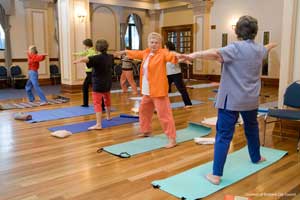Queensland Stay on Your Feet - Trial project evaluation
The evaluation phase of the Queensland Stay on your Feet Wide Bay/Burnett trial project provided the opportunity to:
- identify the process, impact and outcomes of a significant community-based five year trial to inform future directions/implications for falls prevention for all older Queenslanders
- play a part in providing a rigorous contribution to the evidence base regarding population health approaches to falls prevention for older people.
Evaluation approach
As part of good project management, the value of rigorous and comprehensive qualitative and quantitative evaluation of the trial was recognised and considered from the outset as part of planning.
A range of evaluation measures were used, including:
-
an external review of project impacts and outcomes involving analysis of pre- and post-survey conducted using Computer Assisted Telephone Interviews (CATI)
-
an internal evaluation by the project team.
Progress against local community action plans was evaluated each year.
Independent evaluation (by external academics/researchers)
Overall evaluation of the project's impacts and outcomes was undertaken by external, independent, experienced academics/researchers (Queensland University of Technology and Injury Prevention and Control Australia). The external review involved collection and analysis of pre- and post-trial data using a computer-assisted telephone interview (CATI) survey. The survey included impact measures to identify changes in self-reported falls, related injuries and medical treatment; awareness and behaviours relating to major fall risk factors and interaction with health providers.
Stay on Your Feet surveys:
- CATI pre-survey (PDF, 542 KB)
- CATI post-survey (PDF, 537 KB)
The external review also included outcome measures to identify whether there were fewer falls and falls injury experienced by people aged over 60 years living in the community. This was evaluated using hospital admissions (separations) and deaths data, and rates of self-reported falls and falls related injury obtained from the CATI survey.
Internal evaluation (by the project team)
In line with good practice, the project teams at both sites undertook ongoing process evaluation during the implementation of the project to identify if the strategies employed by the project team were accessible to the full geographical area and range of community sectors. In Wide Bay/Burnett, the project team also undertook some evaluation of the impacts of the project.
Evaluation conducted by internal project teams included:
-
the number of programs, services, activities or resources which focused on known falls risk factors
-
number of people/organisations on the mailing list, ensuring that all geographical regions were represented at meetings and events
-
number and range of partnerships
-
number of participants attending relevant community events and their satisfaction with the events.
Evaluation tools used included attendance lists, surveys, a community stocktake and the Community Capacity Index.
Evaluation of local community action plans
Progress against local community action plans occurred annually, based on a 'traffic light' approach originally developed by Queensland Health’s Tropical Population Health Network. The 'traffic light' approach allowed for visual identification of the progress (or lack of) of individual actions to prompt consideration of possible solutions and/or reassessment of the action’s relevance.

Baseline research (2002)
Baseline research was collected at the start of the project to provide a benchmark to compare against on completion of the project. Baseline research added value to the project by:
-
identifying current and relevant local programs, services, activities or resources
-
local data about the incidence of falls
-
local older people’s self-reporting of falls
-
local older people’s attitudes, beliefs and behaviours.
Results
The internal evaluation reported the following positive process results:
-
more activities targeting falls risk factors, particularly physical activity
-
achievement of most major community action plan strategies
-
more local people trained as physical activity leaders, resulting in more physical activities starting and continuing
-
wide exposure to Queensland Stay on Your Feet information in local communities
-
more local government/councils demonstrating commitment to furthering Queensland Stay on Your Feet aims in local communities by new initiatives and inclusion in Council local plans
-
more joint initiatives established in local areas by key partners
-
greater community responsibility to fund ongoing needs resulting in successful funding submissions to support local initiatives.
The final external evaluation reported the following key findings:
- There was a minor and non-specific improvement in some of the risk factors for falls. There was no significant improvement in the incidence of falls-related injury. These findings were the same across both project sites.
- The main finding was that neither community awareness-raising plus community action/development, nor an increased availability of group physical activity opportunities, substantially improve falls risk factors or decrease the rate of falls-related injury.
- Specific to Wide Bay/Burnett, there were some developments in raising awareness among people aged 60 years or over and developing skills among motivated volunteer community members and community service providers. Some improvement was achieved in creating sustainable environments that support older people contemplating or initiating the advocated changes in behaviour, largely through the support of local councils. Efforts were also made to meet the needs of local Aboriginal and Torres Strait Islander peoples.
- Across both project sites, there was less effort directed towards advocating for changes to policies and practices that create known barriers to sustained participation in structured and/or unstructured physical activity by older people. Also, there was not a strong involvement in reorienting services to incorporate enablers such as establishing referral pathways between health practitioners and trained/accredited physical activity leaders; or the integration of recommended physical activity measures in standard professional development and training practices.
Final evaluation report for the Queensland Stay on Your Feet Wide Bay/Burnett Trial Project